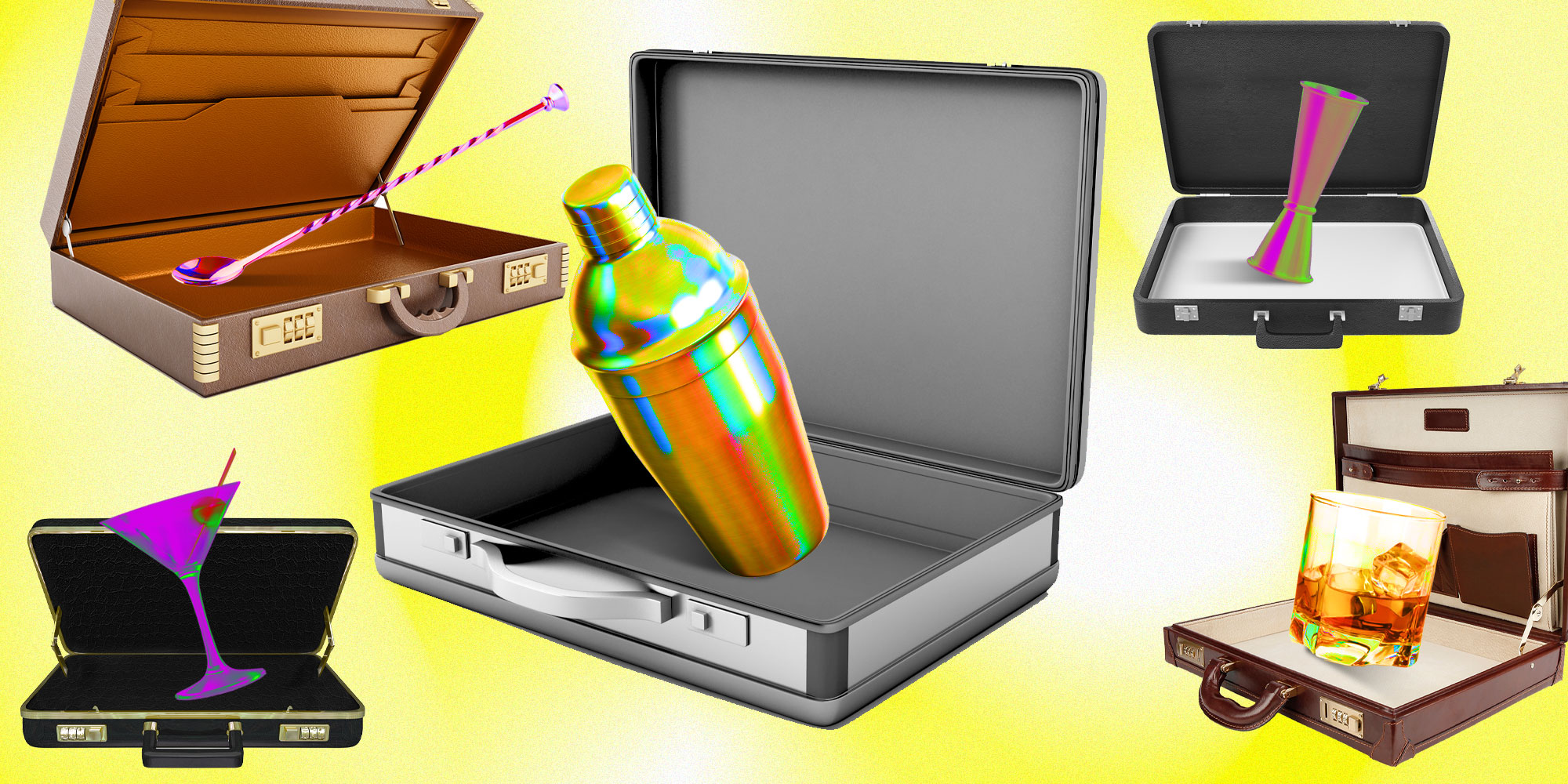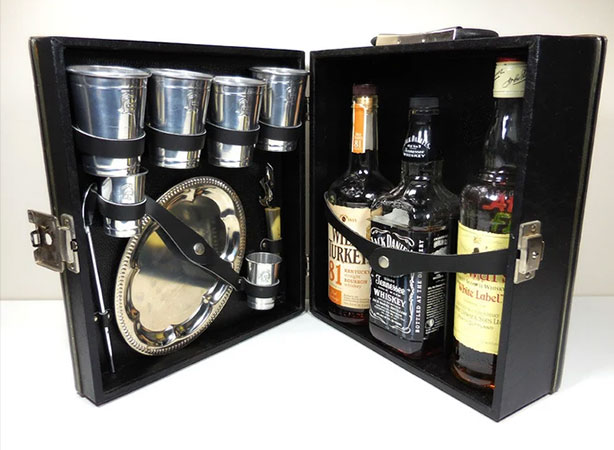
Inside the clipped-shut hard case exterior of my first Executair was a faux-velvet lining, four small metal cups, two metal shot glasses, bar tools, and storage capacity for three bottles. The kit was a package deal: Whenever I arrived at a party, I had my role and conversation starter ready-made. When I called it a night, I was bound for a hangover, as was anyone else who had one too many of my simple-syrup-rich concoctions.
According to a long-saved eBay receipt, a “Vintage Ever-Wear Executair 707 Trav-L-Bar Travel Bar Set with Key Bottles and Accessories” arrived in my life in July 2012. It set me back $50 for the set, $13.17 for shipping. For the next few years, together with my trusty flask, the mobile bar would be a defining feature of my nights out, a growing collection of alcohol-laden suitcases turning every party into an afterparty.
Today, we are living in a golden age of pre-mixed canned cocktails, of portable liquor in discreetly chic packaging. Consider it a side effect of the to-go cocktails of the early pandemic, or the natural outgrowth of hard seltzer brands into more durable, and arguably flavorsome, products. Whatever the cause, for people drinking liquor on the go in a more palatable form than drugstore nips, premixed drinks are to the present what canned craft beer was to drinkers a decade ago.
Before this, underneath the cultural shadow of “Mad Men’s” mid-century stylings, I stumbled into possession of one, then two, then several mobile bars. The Executair offered an alternative to brown paper bags or tailgate coolers. It also represents cocktail culture as affectation and aesthetic, despite the impracticality of mixing drinks on the go.
Mid-Century Marketing
“Trav-L-Bar” first shows up as a coherent phrase in 1956, in the digitized catalogs of both Google Books and the Internet Archive. Fall and winter of that year, especially, saw a flurry of ads for this new mobile bar. The first mention, fittingly, was in the September 1956 issue of Advertising Requirements, a professional magazine of the ad industry.
In a section of “Business Gifts With A ‘Personal’ Touch,” selected by the magazine, the bar is nestled between a skillet with bacon and a French doll. Advertising Requirements described the Deluxe Trav-L-Bar as “a gift for the whole year” that “will be appreciated on trips, picnics, trains, etc.” The case is described as made “of leather-like Surtex,” and is advertised as containing four 8-ounce aluminum glasses, a mixing spoon, a bottle and can opener, and a “bone handled corkscrew.” Not included, but integral to the design, the case has room for, as the ad describes, “two bottles of his favorite brand and a bottle of mix or a cocktail shaker.”

The full size was priced at $16.75, with a smaller case available at $12.75. Adjusted for inflation, that’s $183.52 and $139.69, respectively.
In October 1956, the Trav-L-Bar would get a mention in Financial World as an “Eye-opening gift for the man who has everything,” with the contents listed as “a trim piece of luggage with room for two fifth-bottles of liquor — the product of Ever-Wear Trunk Works, Inc., the unit is fitted with four two-ounce shot glasses, a mixing spoon, combination opener, and cork-screw.”
Road & Track’s December 1956 issue would feature the two-bottle version as “just the thing for travel or outdoor entertaining after the races and such.” Yachting magazine said “the handy two-bottle bar unit will suit the skipper who has broken a few bottles handling them the hard way,” noting the bar “contains compactly the wherewithal for a little pre-dinner relaxation after the hook goes down.”
Perhaps the publication most indicative of the Trav-L-Bar’s desired buyer, the December 1956 Playboy included an ad for the two-bottle unit, saying it “saves time, temper, and tips in hotels and trains — helps prevent frostbite at outdoor sports events — just the thing for patio, game room, office, den, or boat.” The copy stressed that the kit’s four 2-ounce shot glasses were made of “unbreakable polyethylene.”
As pitched, at advertisers and the magazine-reading public, the Trav-L-Bar was an invitation to turn any event into a modest cocktail party. It was a tool of leisure, touted to the business class to enhance those already eager to indulge at sea, on long drives, or even while traveling by train. It fit, broadly, into the post-war revival of cocktail parties, of drinking in community as a kind of social game.
The materials of the Trav-L-Bar also speak to the era, and the availability of consumer goods built around technologies refined for war. Plastic shot glasses were light and novel, far better to take on the road than glass. The synthetic Surtex would in 1961 get dinged by the Federal Trade Commission for not actually possessing enough qualities of leather to be “leather-like,” but by then its form and texture were already iconic with the mobile bars.
Case Loaded
My Trav-L-Bar either came or quickly became stained, with the messiness of drink spilling onto the lined interior. The bar came with a trio of labeled vintage bottles, each designed to hold a pint of Scotch, bourbon, and gin. The gin bottle broke quickly, the bourbon one later, and the Scotch bottle still endures. I found, through experimentation, that reused bottles of Pimms or crème de violette liqueur filled the available space nicely.
With crème de violette on hand, Aviations were an easy go-to, though I’d leave the cherries at home. Black Russians, similarly, traveled well, with vodka and Kahlúa holding up to Uber rides better than the mixture would have lasted with milk mixed in. I also, apparently, made a lot of “Autumn Manhattans,” a stirred blend of bourbon, sweet vermouth, applejack, and bitters that I had completely forgotten about before writing this piece.
While much of the joy of the mobile bar was finding a table and claiming a corner of a party, the ability to recall what was in a given drink diminished as the night wore on. I took to writing out the mixes, proportioned at a single drink, onto name tags slapped onto the bottles. One night my bar contained a pint of Fireball Manhattan, 1.5 pints of Boston Sidecar, and a pint of Arsenic and Old Lace, a Martini-like cocktail that offers another home for the polarizing profile of crème de violette.
In the summer months, I moved on to Pimm’s Cups, with a second bar to hold premixed Arnold Palmers to which Pimm’s and garnish could be added as the drinks were served. Two suitcases full of pre-mixed drinks became a project in and of itself, especially when I’d bring them to a bar before the house party.
One night out, my bar kit included an unmarked bag of powdered sugar, which I envisioned setting on the bar’s silver tray so I could put a sugar rim on glasses before serving a rum-based drink. It took maybe the second incredulous gasp for me to realize that the whole spectacle of the presentation suggested I was about to invite a room full of strangers to watch me snort a line of cocaine before making them drinks.
The thrill of a mobile bar was in its presence and presentation, the idea that drinks could be mixed from a kit on hand. That promise was in tension with the maximum efficiency of pre-mixed cocktails, bottled the morning before and trotted out after work. Bringing enough separated ingredients to mix meant forgoing precious ounces of hard liquor, and in the end, maximum alcohol won out most nights over an appreciation for the craft.
Perpetual Retro
Ads for the Trav-L-Bar recur throughout the late 1950s up through the 1980s. Trav-L-Bars were promoted in newspapers like the San Rafael Daily Independent, as well as magazines like Newsweek that had a broader appeal than the initial trade and men’s magazines it was aimed at. House and Garden in 1960 described the two-bottle kit as “a convenient bar for the busy man on your list. Ideal for business or vacation trips; for home or office.”
The Trav-L-Bar also repeatedly showed up in advertising trade publications. The September-October 1961 issue of Packaging Design wrote, under the header “Hic Transit,” that “masculine fellowship as found in old-time barbershops and ‘men only’ taverns is the theme of this shipping container for the Royalshire Trav-L-Bar.” Fitting for the publication, it emphasized the “Dark brown inks on the kraft container, which was printed by Stone Container Corporation, give the graphics the appearance of a wood-cut.” The special packaging, featuring several bowlered and mustachioed men in an old-timey bar, could blend in seamlessly with the “Cheers” intro.
Ads for the Trav-L-Bar appeared in Sports Illustrated, and began to find a natural home in college newspapers. In 1969, Florida State University’s Florida Flambeau ran an ad featuring two Trav-L-Bars alongside a miniature cooler for a 6-pack of beer, suggesting the direction of the future of portable drinking. The December 1966 issue of Esquire advertised a full spread of Trav-L-Bars, including one that could accommodate five full bottles.
A 1975 spread in Holiday magazine showcased the Trav-L-Bar as an ideal carryon for balloonists. “Our little refreshment stand carries your favorite brand and is ready whenever,” the copy read, echoing earlier pitches, before pivoting right into fiscal responsibility. “And your cost is only 25¢ per cocktail.” Apartment Life magazine included a Trav-L-Bar as part of its 1980 feature on “Aptwares On The Road,” essentials for making a hotel feel like home.
By the last decade of the 20th century, Trav-L-Bar had moved from premium business gift to college kid companion to frugal fancy. In 1997’s “The New York Times Weekends,” an excursion to Labervill in Hunterdon County is recommended for antiquing. One store is worth the trip because it “sells ‘20th-century antiques,’ like campy bar ware from the 1950s, including a “Trav-L-Bar” briefcase complete with tumblers for $65.”
Completing the conversion from retro kitsch to retro chic, 2001’s “Things You Need To Be Told,” a cheeky faux-’50s style guide by “the Etiquette grrls,” includes a special mention for the Trav-L-Bar. It is “the Brand Name of the Etiquette Grrls Trusty Travel Bar, which is how the Etiquette Grrls Carry Their Gin Around.”
Drinksgiving
My original mobile bars were lost to dumpsters and time, part of an apartment move-out defined by shedding possessions through necessity more than intent. I’ve since received another, as a lovely gift from my spouse who could tell I missed the absurdity of the kit.
Today, Trav-L-Bars can be found for sale across the internet, often under the Executair or Trav-L-Bar name. Modern incarnations exist, from REI padded coolers to Tacticool kits set inside gas-can casings. As some places within the United State loosened, at least temporarily, the rules on open containers and outdoor drinking, the utility of a portable cocktail kit has only increased. Though, admittedly, part of the promise and the thrill with a Trav-L-Bar was the promise of a good night to come, libations ported through the routine of the day waiting for the moment of release.
This year, I dusted off the old Executair, and loaded it up to bring to Thanksgiving. The cocktails planned were the Kir Royale and Sex on the Beach, complete with ingredients to make a mocktail version of each. That meant bringing a reusable grocery bag of mixers and add-ons, undercutting the self-contained joy of the bar, but it meant I got to mix drinks as my family asked for them, and to their specifications.
Ultimately, what makes the bar work, and what I suspect has sustained decades of a second-hand market for the kits, is that it’s about the experience shared together, in an unusual setting. Canned booze is — in form, if not content — identical to soda or seltzer. A mobile bar, even one making mocktails, is crafted on the spot.
The article Cases Loaded: A Boozy History of ‘Trav-L-Bars’ and On-the-Go Cocktail Culture appeared first on VinePair.
